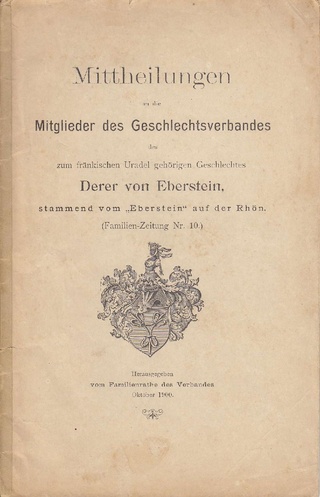
Uradel is a genealogical term introduced in late 18th-century Germany to distinguish those families whose noble rank can be traced to the 14th century or earlier. The word stands opposed to Briefadel, a term used for titles of nobility created in the early modern period or modern history by letters patent. Since the earliest known such letters were issued in the 14th century, those knightly families in northern European nobility whose noble rank predates these are designated Uradel.
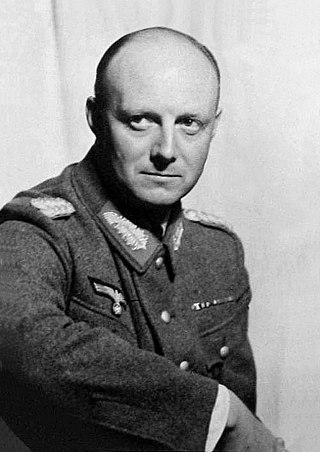
Tresckow is a German aristocratic family originating from Mark Brandenburg and belonging to the German nobility dating back to the middle ages. A prominent branch of the family is known as Treskow and acquired substantial land and wealth in the 18th and 19th century.
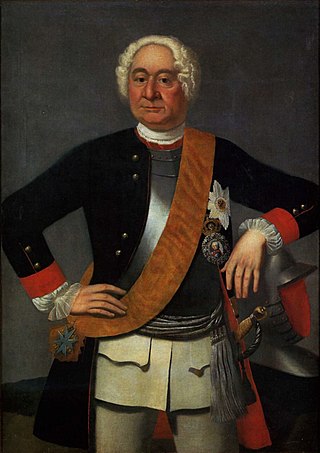
Friedrich Wilhelm von Dossow was a Prussian Generalfeldmarschall and Governor of Wesel.

Barnim XI, son of Bogislaw X, Duke of Pomerania, became duke on his father's death in 1523.
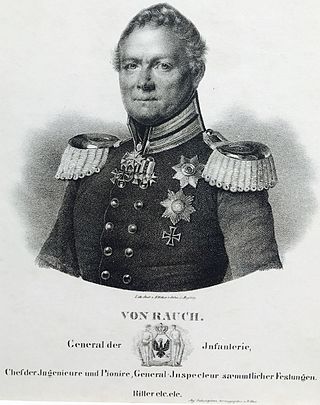
Johann Justus Georg Gustav von Rauch was a Prussian general of the infantry and Minister of War from 1837 to 1841.
Rademacher is a Rhenish family of ancient nobility, that has its roots in the village of Rodemack in Lorraine. They also settled in Middelburg, Netherlands and in the latter also in North Rhine-Westphalia (Aachen), East Prussia (Tilsit), Latvia (Riga) and Hesse (Frankfurt).

Gaffron is the name of a noble family - classified as Uradel - from Silesia.

The House of Moltke is the name of an old German noble family. The family was originally from Mecklenburg, but apart from Germany, some of the family branches also resided throughout Scandinavia. Members of the family have been noted as statesmen, high-ranking military officers and major landowners in Denmark and Prussia.

Merveldt is the name of a Westphalian noble family, which belongs to the nobility of the Middle Ages. The Herrn [Lords] von Merveldt were among the oldest families in the Münsterland. Merfeld, the eponymous seat of the family, is now a neighborhood of the city of Dülmen in the District of Coesfeld in the state of North Rhine-Westphalia in Germany.
Major General Heinrich Christoph Karl Herrmann, Reichsgraf von Wylich und Lottum was a Prussian officer who fought in the Napoleonic Wars including the Waterloo Campaign in 1815.

The House of Sickingen is an old southwest German noble family. The lords of Sickingen belonged to the Kraichgau nobility and from 1797 to the Imperial nobility. Significant relatives emerged from the family, who achieved great influence in both spiritual and secular offices. Reinhard von Sickingen was Prince-Bishop of Worms from 1445 to 1482 and Kasimir Anton von Sickingen was Prince-Bishop of Constance from 1743 to 1750. Imperial Knight Franz von Sickingen (1481-1523) was a leader of the Rhenish and Swabian knighthood.
Johann Christian von Hellbach 15 July 1757 – 18 October 1828) was a German lawyer and writer. He wrote extensively but not exclusively on history.
Ernst Heinrich Kneschke was a German heraldist, ophthalmologist and writer.

Verschuer is a Dutch noble family originally from Appelrebroeck near Barneveld in Gelderland. The family has branches in The Netherlands and Germany. The family name is spelled van Verschuer in Dutch and von Verschuer in German.
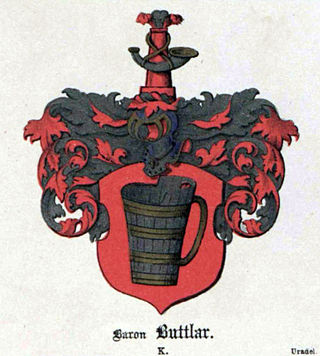
The House of Buttlar is the name of an old Upper Franconian-Hessian noble family. The lords of Buttlar originate from the ancient nobility of Buchonia. Branches of the family also reached Westphalia, Saxony, Prussia, Curonia, France, Poland, Russia and Hungary, and remain partly to this day. The Buttlar and Treusch von Buttlar families of Hessen has since 1660 belonged to the Old Hessian Knighthood, the oldest foundation in Hessen.
von Santen / Zanten is the name of a German noble family from the Rhineland. One of the oldest extant German aristocratic families, they belong to the Uradel of the Prince-Bishopric of Münster.

The House of Pace von Friedensberg is an Austrian noble family of Spanish and Italian origin. The family held the titles of Count of Pace and Baron of Friedensberg within the Holy Roman Empire.

The House of Poschinger is an ancient Bavarian noble family. It traces its origins back to 1140. The family received the rank of Knights of the Holy Roman Empire. The Frauenau branch rose to the rank of Barons (Freiherr) in the Kingdom of Bavaria and held a hereditary seat in the House of Councillors.
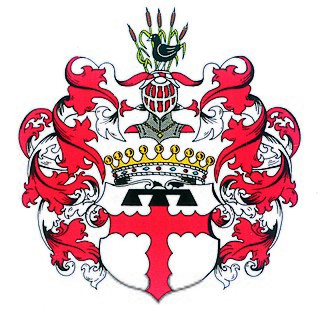
Beissel von Gymnich is the name of an old German aristocratic family, originally from the Lower Rhine, near Cologne. They are still extant and are one of the oldest surviving families of the Uradel, or ancient German nobility.
Baron Wilhelm Hugo von Spitzemberg was a German soldier who became a favourite of King Charles I of Württemberg.
This page is based on this
Wikipedia article Text is available under the
CC BY-SA 4.0 license; additional terms may apply.
Images, videos and audio are available under their respective licenses.














